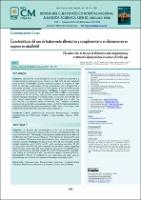Características del uso de tratamiento alternativo y complementario en dismenorrea en mujeres en edad fértil
Related Resource(s)
http://cmhnaaa.org.pe/ojs/index.php/rcmhnaaa/article/view/1459Date
2021-12-31Author(s)
Díaz Vélez, Cristian
Vargas Tineo, Otto W.
Segura Muñoz, Dina M.
Calderón Rodríguez, Karla V.
Apolaya Segura, Moisés
Carhuapoma Yance, Mario
Metadata
Show full item recordAlternate title
Characteristics of the use of alternative and complementary treatment in dysmenorrhea in women of fertile age
Abstract
Objetivo: Describir las características del uso de tratamiento alternativo y
complementario en dismenorrea en mujeres en edad fértil de una ciudad del
norte de Perú. El estudio: Estudio trasversal analítico en mujeres en edad
fértil en Mórrope, Lambayeque. Previa capacitación sobre dismenorrea y
principales variables. Se entrevistó a 336 mujeres en sus domicilios previa
aceptación de consentimiento informado. Hallazgos: Predominó en población
estudiada el grupo etario de 15 a 35 años con 83,92% (n=282), con educación
secundaria el 57,14% (n=192), más del 90% tenían estrato socioeconómico
inferior/marginal. Referente a la dismenorrea, se encontró más del 30% con
dolor severo/insoportable, cuyo tratamiento principal fue la MAC con
82,1%(n=220). Las plantas fueron la principal MAC, hallando solamente
asociación de uso de MAC con la variable religión (p=0,023). Conclusiones: Las
mujeres en edad fértil emplean notoriamente la MAC, como la fitoterapia, como
tratamiento de dismenorrea a pesar de no encuentran alivio. Objetive: To describe the characteristics of the use of alternative and
complementary treatment in dysmenorrhea in women of childbearing age in a
city in northern Peru. The study: Cross-sectional analytical study in women of
childbearing age in Mórrope, Lambayeque. Prior training on dysmenorrhea and
main variables. 336 women were interviewed in their homes after accepting
informed consent. Findings: The age group of 15 to 35 years prevailed in the
studied population with 83.92% (n=282), with secondary education 57.14%
(n=192), more than 90% had lower/marginal socioeconomic status. Regarding
dysmenorrhea, more than 30% were found to have severe/unbearable pain,
whose main treatment was MAC with 82.1% (n=220). Plants were the main MAC,
only finding an association of MAC use with the religion variable (p=0.023).
Conclusions: Women of childbearing age notoriously use CAM, such as
phytotherapy, as a treatment for dysmenorrhea despite not finding relief
Collections
- Artículos científicos [890]






